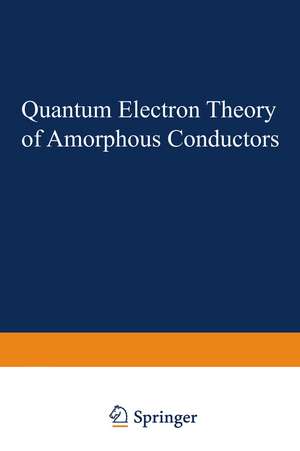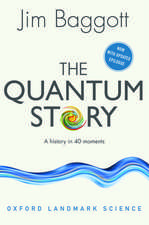Quantum Electron Theory of Amorphous Conductors
Autor Alexsandr I. Gubanoven Limba Engleză Paperback – 2 mar 2012
Preț: 387.38 lei
Nou
Puncte Express: 581
Preț estimativ în valută:
74.13€ • 80.50$ • 62.27£
74.13€ • 80.50$ • 62.27£
Carte tipărită la comandă
Livrare economică 23 aprilie-07 mai
Preluare comenzi: 021 569.72.76
Specificații
ISBN-13: 9781468406696
ISBN-10: 1468406698
Pagini: 296
Ilustrații: XVI, 278 p.
Dimensiuni: 152 x 229 x 16 mm
Greutate: 0.4 kg
Ediția:1965
Editura: Springer Us
Colecția Springer
Locul publicării:New York, NY, United States
ISBN-10: 1468406698
Pagini: 296
Ilustrații: XVI, 278 p.
Dimensiuni: 152 x 229 x 16 mm
Greutate: 0.4 kg
Ediția:1965
Editura: Springer Us
Colecția Springer
Locul publicării:New York, NY, United States
Public țintă
ResearchCuprins
I Review of Experimental Data on Liquid and Amorphous Conductors.- § 1. Electrical Conductivity of Liquid Metals.- § 2. Changes in the Electrical Conductivity of Semiconductors on Melting.- § 3. Correlation Between the Electrical Conductivity and Other Properties.- § 4. Characteristics of the Electrical Conductivity of Liquid Solutions of Metals and Semiconductors.- § 5. Formation of the Glassy State in Semiconducting Systems.- § 6. Electrical Properties of Amorphous Films and Glassy Semiconductors.- § 7. Photoelectric and Optical Effects in Glassy Semiconductors.- § 8. Metal — Ammonia Solutions.- II Fundamentals of the Electron Theory of Solids.- § 9. One-Electron Approximation.- §10. Heitler — London and Hund — Mulliken Methods.- §11. Method of Elementary Excitations.- §12. Justification of the One-Electron Approximation by the Theory of Collective Electron Interaction.- §13. Electron in a Periodic Field.- §14. Principal Methods of Calculating the Energy Spectrum of Electrons in a Crystal.- §15. Calculation of the Mean Free Path of Electrons.- §16. Impurity Levels and Local Electron States.- III Structure of Amorphous Substances.- §17. Phenomenological Similarity of Liquids and Solids.- §18. Molecular Structure of Liquids and Structural Diffusion.- §19. Structure of Liquid Metals.- §20. Structure of Water and of Organic Liquids.- §21. Structure of Glass.- §22. Short-Range and Long-Range Order in Alloys.- §23. Thermal Motion in Liquids.- IV Band Theory for the One-Dimensional Model of a Liquid.- §24. Mechanism of “Melting” in the One-Dimensional Model.- §25. Wave Equation on a Deformed Coordinate Scale.- §26. Calculation of the Perturbation Matrix Elements.- §27. Calculation of the Energy.- §28. Comparison with NumericalCalculations.- V Band Theory for the Three-Dimensional Model of a Liquid [1].- §29. Mechanism of Melting in the Three-Dimensional Model.- §30. Wave Equation in a Deformed System of Coordinates.- §31. Calculation of the Perturbation Matrix Elements.- §32. Calculation of the Energy.- §33. Comparison of the One- and Three-Dimensional Models.- §34. Changes in the Band Width and Effective Mass when Semiconductors Melt.- VI Scattering of Electrons in Liquids by Departures from Long-Range Order and by Defects.- §35. Statement of the Problem.- §36. Discussion of the Electron Motion in a Liquid in Terms of Cartesian Coordinates.- §37. Solution of the Transport Equation for Electrons in a Liquid.- §38. Calculation of the Matrix Element and Estimation of the Electron Mean Free Path in Liquids.- §39. Scattering of Electrons on Defects.- §40. Mechanism of Electron Motion in Liquids.- VII Scattering of Electrons on Thermal Vibrations in a Liquid.- §41. Initial Equations.- §42. Change in the Electron Distribution Function Under the Action of the Acoustical-Mode Vibrations.- §43. Blochls Integral Equation.- §44. Mean Free Path of an Electron Associated with Phonon — Liquid Scattering.- §45. Change in the Electron Distribution Function Under the Action of the Optical-Mode Vibrations.- §46. Electron Mean Free Path Associated with the Phonon — Liquid Scattering in the Case of Optical-Mode Vibrations.- VIII Electrical Conductivity, Thermal Conductivity, Thermoelectric Power, Hall Coefficient, and Nernst Coefficient of Amorphous Substances Exhibiting Electronic Conduction.- §47. General Formulas.- §48. Liquid Metals at T » ?.- §49. Amorphous Covalent Semiconductors.- §50. Amorphous Ionic Semiconductors.- IX Local and Impurity Levels in Amorphous Semiconductors.-§51. Local States in the One-Dimensional Model of a Liquid.- §52. Method of Calculating Local Levels in Many-Atom Systems.- §53. Local Fluctuation Levels in Amorphous Semiconductors [6].- §54. Impurity Levels in Amorphous Semiconductors.- §55. Possible Reasons for the Absence of Impurity Conduction in Amorphous Semiconductors.- X Electron Structure of Liquid Metals.- §56. Calculation Method.- §57. Calculation of the Density of States in Limiting Cases.- §58. Electron Spectrum of Real Liquid Metals.- §59. Wave Functions of Electrons in Liquid Metals.- XI Theory of the Electrical Conductivity of Liquid Metals.- §60. Scattering of Electrons by Metal Atoms.- §61. Plasma Scattering and the Displacement Potential.- §62. Change in the Electrical Conductivity on Melting..- §63. Dependence of the Electrical Conductivity on Temperature and Pressure.- §64. Applicability of the Theory to Multivalent Metals [2].- XII Quasi-Classical Theory of Amorphous Ferromagnets.- §65. Fraction of Antiparallel Spin Pairs.- §66. Average Magnetization and the Curie Point.- Appendix. The Electron State Density in the Band “Tail” of Amorphous Semiconductors.- Literature Cited.














